Intel Xeon Sapphire Rapids: How To Go Monolithic with Tiles
by Dr. Ian Cutress on August 31, 2021 10:00 AM EST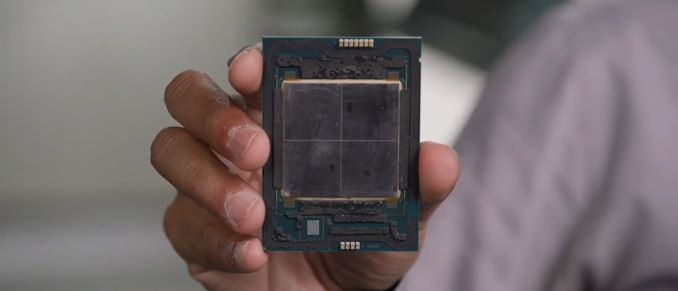
One of the critical deficits Intel has to its competition in its server platform is core count – other companies are enabling more cores by one of two routes: smaller cores, or individual chiplets connected together. At its Architecture Day 2021, Intel has disclosed features about its next-gen Xeon Scalable platform, one of which is the move to a tiled architecture. Intel is set to combine four tiles/chiplets through its fast embedded bridges, leading to better CPU scalability at higher core counts. As part of the disclosure, Intel also expanded on its new Advanced Matrix Extension (AMX) technology, CXL 1.1 support, DDR5, PCIe 5.0, and an Accelerator Interfacing Architecture that may lead to custom Xeon CPUs in the future.
What is Sapphire Rapids?
Built on an Intel 7 process, Sapphire Rapids (SPR) will be Intel’s next-generation Xeon Scalable server processor for its Eagle Stream platform. Using its latest Golden Cove processor cores which we detailed last week, Sapphire Rapids will bring together a number of key technologies for Intel: Acceleration Engines, native half-precision FP16 support, DDR5, 300-Series Optane DC Persistent Memory, PCIe 5.0, CXL 1.1, a wider and faster UPI, its newest bridging technology (EMIB), new QoS and telemetry, HBM, and workload specialized acceleration.
Set to launch in 2022, Sapphire Rapids will be Intel’s first modern CPU product to take advantage of a multi-die architecture that aims to minimize latency and maximize bandwidth due to its Embedded Multi-Die Interconnect Bridge technology. This allows for more high-performance cores (Intel hasn’t said how many just quite yet), with the focus on ‘metrics that matter for its customer base, such as node performance and data center performance’. Intel is calling SPR the ‘Biggest Leap in DC Capabilities in a Decade’.
The headline benefits are easy to rattle off. PCIe 5.0 is an upgrade over the previous generation Ice Lake PCIe 4.0, and we move from six 64-bit memory controllers of DDR4 to eight 64-bit memory controllers of DDR5. But the bigger improvements are in the cores, the accelerators, and the packaging.
Golden Cove: A High-Performance Core with AMX and AIA
By using the same core design on its enterprise platform Sapphire Rapids and consumer platform Alder Lake, there are some of the same synergies we saw back in the early 2000s when Intel did the same thing. We covered Golden Cove in detail in our Alder Lake architecture deep dive, however here’s a quick recap:
The new core, according to Intel, will over a +19% IPC gain in single-thread workloads compared to Cypress Cove, which was Intel’s backport of Ice Lake. This comes down to some big core changes, including:
- 16B → 32B length decode
- 4-wide → 6-wide decode
- 5K → 12K branch targets
- 2.25K → 4K μop cache
- 5 → 6 wide allocation
- 10 → 12 execution ports
- 352 → 512-entry reorder buffer
The goal of any core is to process more things faster, and the newest generation tries to do it better than before. A lot of Intel’s changes make sense, and those wanting the deeper details are encouraged to read our deep dive.
There are some major differences between the consumer version of this core in Alder Lake and the server version in Sapphire Rapids. The most obvious one is that the consumer version does not have AVX-512, whereas SPR will have it enabled. SPR also has a 2 MB private L2 cache per core, whereas the consumer model has 1.25 MB. Beyond this, we’re talking about Advanced Matrix Extensions (AMX) and a new Accelerator Interface Architecture (AIA).
So far in Intel’s CPU cores we have scalar operation (normal) and vector operation (AVX, AVX2, AVX-512). The next stage up from that is a dedicated matrix solver, or something akin to a tensor core in a GPU. This is what AMX does, by adding a new expandable register file with dedicated AMX instructions in the form of TMUL instructions.
AMX uses eight 1024-bit registers for basic data operators, and through memory references, the TMUL instructions will operate on tiles of data using those tile registers. The TMUL is supported through a dedicated Engine Coprocessor built into the core (of which each core has one), and the basis behind AMX is that TMUL is only one such co-processor. Intel has designed AMX to be wider-ranging than simply this – in the event that Intel goes deeper with its silicon multi-die strategy, at some point we could see custom accelerators being enabled through AMX.
Intel confirmed that we shouldn’t see any frequency dips worse than AVX – there are new fine-grained power controllers per core for when vector and matrix instructions are invoked.
This feeds quite nicely into discussing AIA, the new accelerator interface. Typically when using add-in accelerator cards, commands must navigate between kernel and user space, set up memory, and direct any virtualization between multiple hosts. The way Intel is describing its new Acceleration Engine interface is akin to talking to a PCIe device as if it were simply an accelerator on board to the CPU, even though it’s attached through PCIe.
Initially, Intel will have two capable AIA bits of hardware.
Intel Quick Assist Technology (QAT) is one we’ve seen before, as it showcased inside special variants of Skylake Xeon’s chipset (that required a PCIe 3.0 x16 link) as well as an add-in PCIe card – this version will support up to 400 Gb/s symmetric cryptography, or up to 160 Gb/s compression plus 160 Gb/s decompression simultaneously, double the previous version.
The other is Intel’s Data Streaming Accelerator (DSA). Intel has had documentation about DSA on the web since 2019, stating that it is a high-performance data copy and transformation accelerator for streaming data from storage and memory or to other parts of the system through a DMA remapping hardware unit/IOMMU. DSA has been a request from specific hyperscaler customers, who are looking to deploy it within their own internal cloud infrastructure, and Intel is keen to point out that some customers will use DSA, some will use Intel’s new Infrastructure Processing Unit, while some will use both, depending on what level of integration or abstraction they are interested in. Intel told us that DSA is an upgrade over the Crystal Beach DMA engine which was present on the Purley (SKL+CLX) platforms.
On top of all this, Sapphire Rapids also supports AVX512_FP16 instructions for half-precision, mostly for AI workloads as part of its DLBoost strategy (Intel was quite quiet on DLBoost during the event). These FP16 commands can also be used as part of AMX, alongside INT8 and BF16 support. Intel now also supports CLDEMOTE for cache-line management.
A Side Word about CXL
Throughout the presentations of Sapphire Rapids, Intel has been keen to highlight it will support CXL 1.1 at launch. CXL is a connectivity standard designed to handle much more than what PCIe does – aside from simply acting as a data transfer from host to device, CXL has three branches to support, known as IO, Cache, and Memory. As defined in the CXL 1.0 and 1.1 standards, these three form the basis of a new way to connect a host with a device.
Naturally it was our expectation that all CXL 1.1 devices would support all three of these standards. It wasn’t until Hot Chips, several days later, that we learned Sapphire Rapids is only supporting part of the CXL standard, specifically CXL.io and CXL.cache, but CXL.memory would not be part of SPR. We're not sure to what extent this means SPR isn't CXL 1.1 compliant, or what it means for CXL 1.1 devices - without CXL.mem, as per the diagram above, all Intel loses is Type-2 support. Perhaps this is more of an indication that the market around CXL is better served by CXL 2.0, which will no doubt come in a later product.
In the next page, we look at Intel's new tiled architecture for Sapphire Rapids.



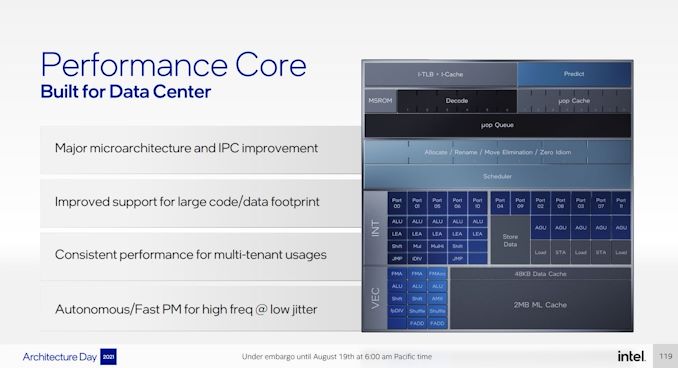


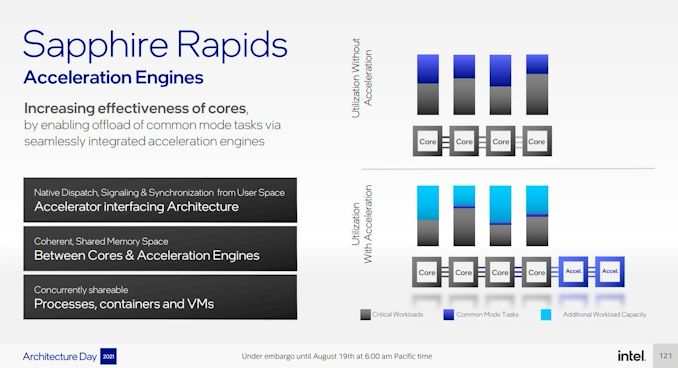
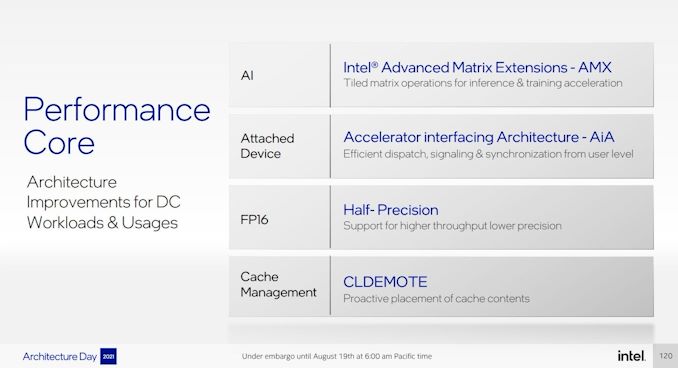
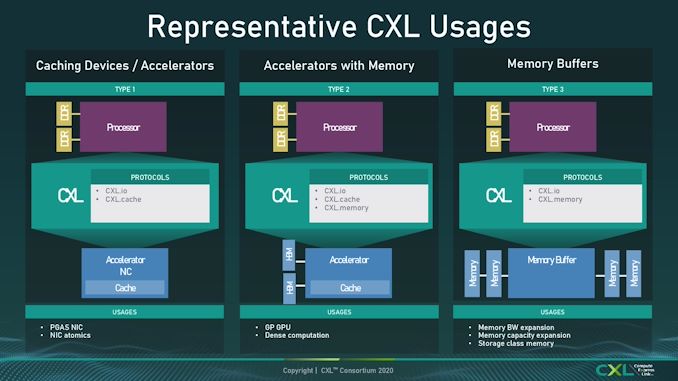








94 Comments
View All Comments
Silver5urfer - Wednesday, September 1, 2021 - link
Knights Landing was Atom based platform. Tons of Atom cores on a giant LGA4xxx socket and it died. The only reason they shoved those pathetic cores onto LGA1700 is to compete in SMT applications against Ryzen without blowing a hole in the power consumption. Once we get the TDP of these new Xeon SPR processors we will get an idea on how a 14C tile operates, they avoided going 14C on the desktop also due to scaling them onto the crappy BGA trashware where their efficiency works to combat Apple M series and AMDs APUs. That is the highest margin for Intel apart from Datacenter business of Xeon. Their desktop is lowest priority of all 3. So they do not care about that but they wasted ton of cash on that stupid Intel Thread Director.drothgery - Wednesday, September 1, 2021 - link
They've made some "lots of Atom cores" processors before; it wouldn't be too shocking if they did again. Though swapping out 14X Golden Cove tiles for 56X Gracemont tiles to build a 224-core monster seems ... improbable.Duncan Macdonald - Wednesday, September 1, 2021 - link
Power consumption ?Recent Intel CPUs have been power hogs when the frequency is raised sufficiently to start to compete with the AMD CPUs. (So much so that Cloudfare gave up on Intel CPUs in its recent servers (See https://www.theregister.com/2021/09/01/cloudflare_... for more details).)
For any large scale deployment of servers, the power consumption of the servers is as important as their performance. A quote from a Cloudflare engineer "Although Intel's chips were able to compete with AMD in terms of raw performance, the power consumption was several hundred watts higher per server – that's enormous."
Ian Cutress - Wednesday, September 1, 2021 - link
Product information not disclosed. This was an architecture presentation.TristanSDX - Wednesday, September 1, 2021 - link
no benches :(edzieba - Wednesday, September 1, 2021 - link
"This means that if SPR is going to offer versions with fewer cores, it is going to either create dummy tiles without any cores on them, but still keep the PCIe/DDR5 as required, or quite simply those lower core counts are going to have fewer memory controllers."Or these mirrored die pairs will have very aggressive stratified binning.
msroadkill612 - Wednesday, September 1, 2021 - link
Intel rely on short memories.When Zen appeared, they were notorious for forcing multi socket servers (gouging) on folks who really only needed single sockets - the exact opposite of aiming for better processor interconnects.
They know how vital tdp is as a metric.
If their solution is so competitive - why does it push the maximum acceptable tdp limits? It smacks of desperation.
wrkingclass_hero - Thursday, September 2, 2021 - link
It looks like they pulled out a dusty chip from under the fridge for that press pickwrkingclass_hero - Thursday, September 2, 2021 - link
*picAlexvrb - Sunday, September 5, 2021 - link
"The word ‘channel’ has often been interchangeable with ‘memory slot’ to date, but this will have to change."I get what you're saying, but as-worded that hasn't been true like... ever. I'm typing this on a newfangled dual channel system with 4 (count em, 4!) memory slots. I know it would be confusing to say you've got 16 x 32 bit channels for 8 or 16 modules, people might think you're only enabling half the channels with 8 modules. You could always specify double-channel modules or something of that nature.